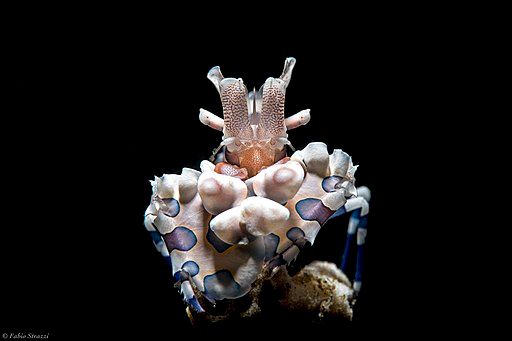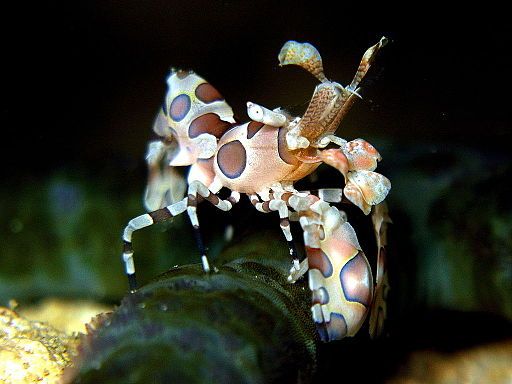[ad_1]
The Harlequin shrimp, in my opinion, is one of the most beautiful marine invertebrates in the world. Just take a look. They are mostly white with colorful spots all over their mantis-shaped body. In general, they grow to a maximum size of 2 inches. Females will be significantly larger than males. The three most common reasons aquarium owners consider purchasing them are:
- Because they are gorgeous
- To clear up an asterina starfish infestation
- To watch their amazing hunting behavior
Here are a few questions people also ask:
Scientific name and common names
Hymenocera picta is the scientific name of the harlequin shrimp. Be sure to remember that, in case it comes up the next time you play Quizzo.
Natural habitat
Harlequin shrimp are found on the rubble piles outside of coral reefs from Hawaii to the Indo-Pacific region. There are regional color differences, with the Indo-Pacific specimens having white bodies with maroon to purple spots with blue outlines. In contrast, the Hawaiian variant has a white-to-cream-colored body with bright pink to magenta-colored spots.
In their natural habitat, shrimp form breeding pairs that rarely move more than a few inches away from each other. Their pairing is thought to be both for the purposes of mating and for the added benefit of having a hunting partner–which is bad news if you’re a starfish.
Placement in the tank
These shrimp tend to be shy at first and need a safe place to hide. Often times they will pick a cave and turn that into their lair. They use this for resting and for eating, dragging their prey into it to eat in safety.
They need water temperatures between 72 and 84 degrees Fahrenheit and are very susceptible to water chemistry and salinity changes. Water changes need to match both chemically and in temperature. They can not handle copper or nitrates in the water (chemicals commonly used to treat parasite infestations in fish).
The shrimp are also vulnerable to strong currents and will shy away if your tank has too much flow.
A quick scan of forum posts discussing these colorful crustaceans show numbers of posts from people who lost their fish to their powerhead filters. Finding circulation and filtration systems that don’t create too much current in the tank is an absolute must for keeping harlequins happy and healthy.
A gyre pump may be best for these shrimp if you intend to keep them in a larger reef tank.
However, because of their size and delicate structure, you may want to try keeping them in a nano tank, where they can be more secure (and therefore visible) and be the main focus.
Molting
Hymenocera picta, like all shrimp, shed their exoskeletons as they grow because their hard outer shell doesn’t grow with them.
As they grow, a new shell develops under the old one.
When it’s ready to grow, their old shell splits open, and they emerge in their new shell.
Occasionally an old shell will come off in such a perfect piece that it will appear like the shrimp is dead and lying motionless on the bottom of the tank.
The problem is often made worse because a freshly molted shrimp knows that its new exoskeleton is still soft and vulnerable to predators and will hide for a few hours until it hardens. So don’t jump to conclusions too quickly if you find a lifeless carapace in your tank.
Are harlequin shrimps reef safe?
Yes, harlequin shrimps are considered to be reef safe, with one big exception. They eat echinoderms (starfish), so they are not compatible with starfish, but they will leave corals and fish alone.
Compatibility and Harlequin shrimp tank mates
Hymenocera picta can be kept with smaller fish and many kinds of crabs. Other shrimp can be an issue, though, as all shrimp tend to be territorial.
Harlequin shrimp do not have a lot of natural predators in the wild.
However, in a tank setting, they are likely to be picked on by any fish that eats shrimp.
Wrasses, in particular, can be a problem, but any large fish can pose a potential threat. Even if the larger fish don’t eat the shrimp, the threat from predators can keep them in hiding. It goes without saying (although I guess I am saying) that it is not wise to keep this shrimp with fish known to eat shrimp, like dwarf lionfish or hawkfish.
Since their natural food is starfish (more on that in a bit), don’t keep them with any decorative starfish or sea urchins that you don’t want to see eaten.
Reproduction
Harlequin shrimp prefer to live in breeding pairs and will spawn every month or so.
Raising them from their larval stage in a home tank has been met with limited success. However, just last year, a commercial aquarium company was able to get 500 harlequins from larval to adulthood. Hopefully, there will be more success, and a methodology for home propagation will be available soon.
How long do harlequin shrimp live?
A few websites report that harlequin shrimp live for about 7 years. Anecdotal reports online from hobbyists suggest about 2-3 years once introduced to the tank.
Sources:
Aquarium breeder
Fishkeeping world
Reef central
Harlequin Shrimp Care and Feeding
Harlequin shrimp only eat starfish (and in times of absolute desperation, sea urchin). Specifically the tube feet of starfish. There is no alternative food source you can easily entice them with. A pair of harlequins goes on the hunt for starfish, able to smell their prey, even if the echinoderm is hidden.
Once they find a starfish, they will stand on top of it to immobilize it before flipping it over. As soon as the starfish is on its back, the pair will begin to drag it to their lair for feasting upon it.
A single harlequin shrimp can make a starfish last up to two weeks. Generally speaking, they start eating at the point of the star and work their way through the tube feet toward the center. Some hobbyists have reported that their harlequins will even bring algae into their cave to force-feed the starfish to keep it alive and fresh for their dining.
Some starfish species can shed their legs to get away from predators and will do this when being eaten by the shrimp. Because of their very particular tastes, harlequin shrimp can be quite expensive to keep. Chocolate chip starfish are some of the lowest-cost options, and even those come in at $9-$12 each.
Do Harlequin shrimp eat asterina starfish?
Yes, harlequin shrimp eat asterina starfish and just about any other species of starfish you might find or purposefully add to your tank. In fact, they only eat starfish and often starve in a home reef tank.
Preventing them from starving
Since these shrimp have voracious appetites and will only eat starfish, you probably need a plan to ensure you will always have food available. Here are a few thoughts (all with their own level of reasonability and humaneness):
- Let everyone you meet in the hobby, or with a store, that you’re happy to take their leftover asterina starfish.
- Try to get Asterina sp. starfish to set up shop in your tank.
- Asterina stars are generally considered pest species, often hopping a ride into your tank with your newest arrivals from the LFS.
- To harlequin shrimp, they are a buffet. A pair of hungry harlequins could polish off 15 of these little guys every day, so using them as your sole feed is probably unrealistic, but if you’ve already got a problem with them killing your coral, harlequin shrimp could be the answer.
- Set up a starfish farm (ew…gross)
- The idea is to keep a handful of starfish known to quickly regrow their arms in small separate tanks (they are all also known to be cannibalistic) and remove a leg from them every day on a rotating basis to feed to your shrimp.
- If you have enough, they will regenerate their arms before it’s their turn to give up another one. Aside from having to cut the legs off a live animal every day, the downside of this operation is the space and resources necessary to keep all the stars separate and alive.
- Stock up.
- If you ever find a sale on starfish, you probably want to buy them in bulk.
- This could cut down on some costs if you are willing to find space in your freezer for them or have a tank for them.
- It’s important to note that frozen starfish do rot faster in the tank, meaning that feeding smaller pieces more often will be necessary.
Conclusion
Harlequin shrimp are gorgeous. It is amazing to watch their hunting behavior and how adeptly they can disarm (pun intended) an unexpected starfish, but raising them in a reef tank certainly comes with many challenges. Their dietary needs aren’t for the faint of heart (or those on a budget). Regardless of how starfish, be ready to be on clean-up duty. Harlequin shrimp eat starfish feet. They won’t eat the whole starfish. So the rest of the body will be left in your tank…to rot. Ugh.
Most clean-up crews won’t eat the outer bits of the stars, meaning that regularly removing decaying starfish from the tank is a chore that accompanies harlequin shrimp ownership.
What do you think? Would you consider keeping one? Share your thoughts below:
For more information
If you would like to learn more about a great shrimp species that is a little easier to care for, check out:
If you want to find another awesome aquarium predators, check out:
Want to learn more about caring for the harlequin shrimp in your saltwater aquarium? Check out this video:
[ad_2]
Source link








